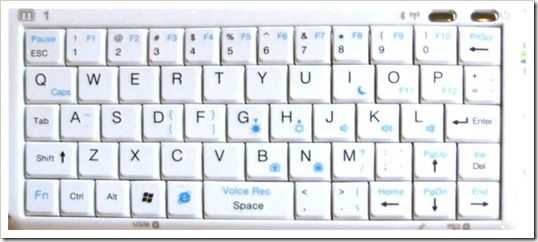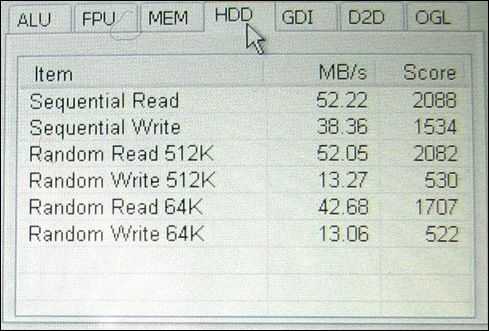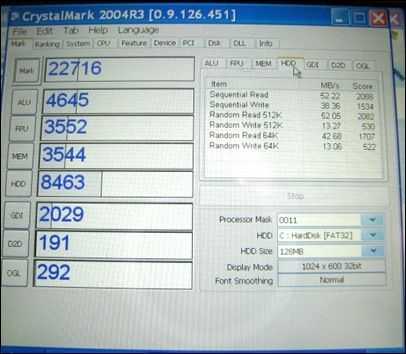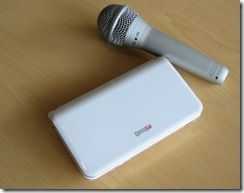Clearly, one of the most interesting and attention-grabbing devices we had at SXSW was the tiny clamshell form-factor UMID MBook. It’s design, a combination of a familiar form factor and attractive styling, has been highlighted by commenter’s as a winning combination ever since it first appeared in Nov 2008. Between then and now, very few people have had the chance to get quality time with it. Lazion, a Korean website, teased us with some early hands-on last month and Slashgear got some thumbs-on with the keyboard at Mobile World Congress so now it’s time for me to try and knit all that info together with what I experienced and tested out in Austin.
Specifications
For such a tiny (pocketable) and light (315g) device, it carries a huge amount of power. The 1.3Ghz, hyperthreading enabled Atom Z520 CPU returns an estimated 6-10 times the CPU processing power of an iPhone and a noticeable increase in speed over the Compal MID that I’ve tested a number of times. The Wibrain i1 that I’ve also tested was the most powerful javascript engine I’ve ever testing in terms of power/weight ratio. With the UMID coming in even lighter, you get even more power per pound. XP home runs on 512MB RAM which, although quite shocking in this day and age, is really not a problem. XP Home uses a very small memory footprint leaving space for the usual mobile desktop application suite. The best part of the package though lies in the SSD. UMID have chosen one of the fastest stock SSD’s I’ve seen in a ultra mobile PC (Sony Vaio P and Samsung Q1 U SSD are a little faster I believe) and certainly the fastest storage you can put in your pocket. Not only does it speed up application startup but it also helps with the shortage of memory. If disk swapping needs to be done, it’s going to happen quickly.
Full UMID MBook specifications at UMPCPortal
Around the right of the device you’ll find a DMB antenna (local Korean digital terrestrial TV), a DC input, a USB and audio breakout port (requires dongle.) The micro SD , built-in mic and SIM card slot (for 3G-enabled versions) are on the front along with a stylus. The left side is blank. The battery, a cylindrical package slots in on the back and is a useful 18Wh.
Opening up the device you’ll find an 800×480 screen (optimal for an easy-out-of-the box, 20-30cm web experience) [Note: A 1024×600 screen is available. It’s even possible that this *was* a 1024×600 screen with a nicely optimised icon, font size and window setup.] with bright colours and a good LED backlight. Above the keyboard on the top-right are buttons for on/off and wifi/BT enable.

Note: Best efforts rotation and perspective correction from this image.
The Keyboard.
The main and most obvious feature of the UMID is the keyboard. The unit is designed to be ‘thumbed’ while being held in two hands and in that mode, its one of the most comfortable thumb-style keyboards I can remember. It’s very close in style and feel to the Everun Note keyboard but with a much easier size for thumbing. Numerics and Function Keys are provided along with a series of FN-shortcuts that start applications like explorer and the voice recorder app (untested.) The only issue with the keyboard might be the lack of the right-side shift key. Yes, it immediately trips you up as you try and thumb over to the left shift but as I’ve found with this and other single-shift keyboards, you get used to it. Sticky-keys may also help.
Storage.
I mentioned that the SSD is fast but there was only 8GB of it on the device I tested. With 16GB SDHC Micro-SD cards available at good prices now though and an option for a 16GB SSD, there shouldn’t be a major problem satisfying your requirements unless you really must carry a huge MP3 or video library with you all the time. Photographers may also hit limits if they’re using this as a storage and photo-review unit. A disk read/write test result is shown below. It’s way above the average for a device in this category.
Screen.
The screen is a soft-touch unit with excellent brightness. One thing I immediately noticed is that the touch driver somehow tries to stabilise finger-pointing ‘wobble’ which I found a great help for selecting icons. I’m not sure if this would have any negative effect anywhere else but it certainly felt good to me. 800×480 is entry-level for a MID in my opinion and the screen also meets the requirements for bright-room operation. The screen doesn’t fold right back which might be awkward in some situations but for the normal two-handed thumbing mode, it was fine. On the top-right of the screen frame you’ll find a 1.3mp cam. (untested)
Battery life.
The Menlow platform has really helped to keep the battery drain figures down. 2 years ago, a similar device would have been consuming 10W. The UMID appears to use about half of that with 3hrs active, wifi-on use. Use of battery-save mode (CPU at 800Mhz) and a lower screen brightness is going to allow up to 4hrs with Wifi on. Considering that battery is so tiny, carrying a spare to give you full working-day capability makes this one of the lightest all-day computing solutions you can buy.
Full gallery containing MIDMoves, press and other photo’s of the UMID M1 are available here.
Build Quality.
One of the unknowns right now is build quality. The device I tested was a prototype and suffered from a poor screen hinge that made an worrying clicking sound as you opened it up. The plastics and fittings didn’t appear to be top quality either. Blanking plates over the ports were quite loose and felt fragile. I’ve heard that UMID are addressing some early quality issues though so until I see a final retail version, I can’t tell if this is really going to be a problem or not.
Performance
I used the UMID M1 on and off over a period of about 3 days and for my scenario, email, web, Twitter client, Gtalk and image posting, it was excellent. Application start-up times, standby and system startup were all quick (Cold start to XP use was about 40 seconds.) The 1.3Ghz processor can crunch web pages very well (sub-10-second average load time) and the Wifi seemed to be reasonable. (Note, Wifi hotspot performance at SXSW ranges from excellent to poor so this is a difficult one to judge)
Testing with CrystalMark shows up the excellent SSD speeds and other results that are on-par with other Menlow-based MIDs.
Other notes
-
No Draft-N support
-
No GPS
-
USB requires adapter
-
Design not suitable for in-car navigation use.
-
No mouse control
-
No noise, heat issues. (Appears to be fanless)
Untested:
-
HSDPA
-
Speaker volume/quality
Final thoughts
During SXSW I also spent a lot of time with the Fujitsu Loox (similar to the U820) and it was interesting to compare differences. The Loox has 1GB of RAM and a 1.6Ghz Atom CPU but the heavyweight Vista installation meant that the lower-powered, faster disk UMID was faster and more reliable, expecially coming out of standby. Of course the screen real-estate and keyboard size on the Loox means you can peck a decent WPM out while on a desk and the UMID M1 didn’t feel comfortable on a table. It really is focused as a handheld thumbing-style MID. Compared to the Viliv S5, I was also demonstrating, it didn’t feel as solid and rugged either. Battery life was noticeably better on the S5 too but that’s due to the 24Wh battery it has in place of a keyboard.
Overall though, the technical specs, the size, the form factor, the style and the connectivity make this an excellent device for mobile communications, mobile blogging and emergency PC work of any kind. It really highlights how far the ultra mobile platforms have moved on over the last year too. Those itching to press an order button somewhere probably aren’t going to be disappointed with the capability of the device but if you can wait to get feedback on the final retail build quality, it might be prudent.
You can find more information including specifications and the latest newslinks, images, reviews and videos on the UMID on this page at UMPCPortal
The SXSW MIDMoves event was sponsored by Intel. This review was written and edited by Steve Paine with no external control or guidelines.















You forgot to say there is 1024 x 600 resolution version too..
The one I tested at CeBit was 1024 x 600: http://jkkmobile.blogspot.com/2009/03/umid-m1-at-cebit-2009.html
Yup. Thanks JKK. There is indeed a 1024×600 version. It’s even possible, I guess, that this was a 1024×600 version with a nicely modified XP font, window and icon setup!
I am very interested in this device. However, I recently found a very reasonably-priced refurb Fujitsu U810, so I picked one of those up instead.
However, most of my big-ticket tech purchases have been of the refurb variety, anyway. Maybe I’ll follow the same pattern with the M1 and wait till they’ve been on the market for a while and refurbs start to appear. ;)
It looks like a great little mobile device, though. I hope it does well when it becomes available.
Quote: ‘and certainly the fastest storage you can put in your pocket. Not only does it speed up application startup but it also helps with the shortage of memory.’
Are you saying that if I put an SSD in my pocket it will help with my shortage of memory? That would be so cool!
:-) You can read it that way if you like. Let mke know if you test the theory!
When does it (UMID MBOOK) on sale?
We’re expecting April or May in Europe and US for non-3G versions.
Dear sir;
Do you have 3G-enabled versions on sale now? Thanks
I just want to ask if there’s a dvd-rw drive in umid mbook.
and i’m confused of the choices you can have in buying the umid mbook. there are some that said that you can buy a linux-based or windows xp-based OS of the mbook.there are some that said that you can buy an mbook with 1024 x 600 resolution or an mbook with 800×480 resolution.and lastly, there are some that said that you can buy an mbook with 1.1 ghz processor or an mbook with 1.33 ghz processor of mbook.I just need clarifications with these choices.
I think this is one cool gadget to start with. small and amazingly comes with a physical keyboard. fits just into my pocket also. i love it.